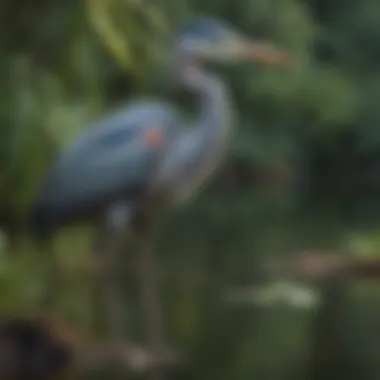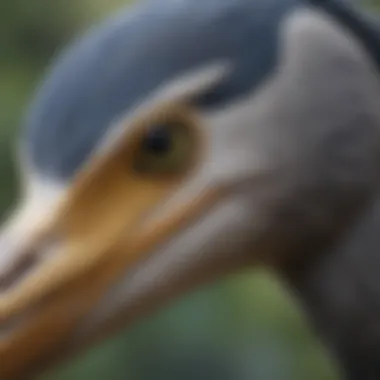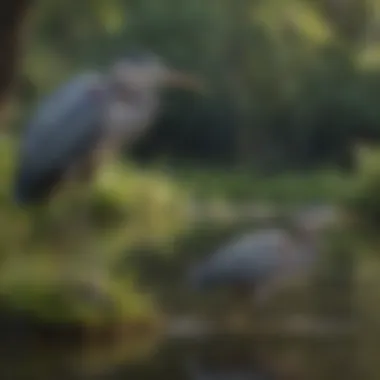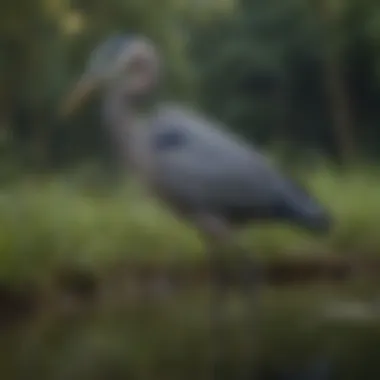The Intriguing Impact of Fake Blue Herons in Ecosystems


Intro
The concept of the fake blue heron encompasses both artifice and nature. Often represented through decoys, these replicas serve specific purposes in wildlife observation and hunting. This section will explore key aspects surrounding these imitations and their relevance to ecology, ethics, and the human experience.
Understanding the role of the fake blue heron helps illuminate critical conversations among wildlife enthusiasts, environmentalists, and casual observers alike. With a focus on design, impact, and public perception, we will delve into this unique subject thoroughly.
Fascinating Facts About the Animal
This section aims to dissect the intricate details surrounding the fake blue heron, particularly how these decoys mimic the real birds in both appearance and function.
Unique Characteristics
Fake blue herons are often crafted from durable materials designed to withstand harsh weather conditions. Most commonly made from plastic or fiberglass, these decoys can mimic the posture and coloration of actual blue herons effectively. Their design includes features such as realistic feathers and positioning that aim to deceive both wildlife and human observers.
- Material: Generally made from robust plastics or fiberglass.
- Coloration: Carefully painted to replicate the vibrant hues of real blue herons.
- Positioning: Strategically placed to simulate active behaviors such as feeding or resting.
Extraordinary Abilities
While these decoys do not possess biological abilities, they provide various functional advantages to their users. They can enhance wildlife observation experiences by drawing in authentic animals, creating opportunities for education and enjoyment. Additionally, they can assist hunters in creating a realistic environment for attracting prey. In this sense, the fake blue heron plays a significant role in bridging the gap between human activities and nature.
Behavior and Habitat
The fake blue heron is a man-made object in stark contrast to the behavior and habitats of its live counterparts. By examining these differences, we can gain insights into how such devices alter interactions within ecosystems.
Natural Habitats
Blue herons are commonly found in wetlands, marshes, and along shorelines. They thrive in areas rich with fish and amphibians, as their diet primarily consists of such creatures. The habitats of real blue herons provide context for understanding where decoys are usually deployed.
Social Structures
Real blue herons often exhibit social behaviors, especially during breeding seasons. They can form colonies at nesting sites, where they communicate and learn from each other. Fake blue herons do not possess social structures but rely on their ability to imitate these traits to create a semblance of normalcy in nature.
Recent Scientific Discoveries
Innovative developments in technology and design contribute to our understanding of wildlife imitation devices. By integrating recent research findings, we can appreciate the advancements in the field.
Latest Research Findings
Research has shown that the deployment of realistic decoys can significantly affect wildlife behavior. Studies indicate that carefully placed fake blue herons can improve the chances of real herons returning to specific areas, as they rely heavily on visual cues.
Breakthroughs in Animal Biology
The study of animal behavior and ecology has advanced with technology. Researchers are using data collected from the interaction of fake blue herons and real birds to inform conservation strategies. Understanding how wildlife responds to imitation can help shape better environmental management practices.
Cultural Significance
The presence of the blue heron in various cultures adds an intriguing layer to our understanding of its representation through decoys. This section will explore the broader implications of these birds.


Animals in Folklore
The blue heron appears in numerous mythologies and folklore, often symbolizing wisdom, patience, and resilience. These narratives sometimes influence how people perceive the need for imitation through devices like decoys.
Influence on Art and Literature
Artists and writers have long been fascinated by blue herons, often depicting them as symbols of grace and natural beauty. Their representation in decoys offers a unique interaction between nature and art, as the design seeks to recreate their elegance.
The study of fake blue herons transcends mere functionality; it opens up dialogues about ethics, conservation, and appreciation of the natural world.
By analyzing the significance, design, and impact of the fake blue heron, we can gain a deeper understanding of its role in our ecosystem and its mixture of realism and imitation.
Preamble to the Fake Blue Heron
The use of fake blue herons in wildlife observation and management is a captivating yet often misunderstood subject. These decoys play a dual role, serving both practical observations while raising important ethical questions. Understanding the fake blue heron involves grasping its design, purpose, and the broader context in which it functions. This particular segment lays the groundwork for a comprehensive exploration of how these artificial birds integrate into ecosystems, and beyond that, what implications they carry in both wildlife observation and human intervention in nature.
Defining the Fake Blue Heron
The term fake blue heron typically refers to realistic decoys crafted to resemble the actual bird. While they may appear simple, successful decoys are the result of thoughtful design. These replicas mimic both the appearance and behavior of real blue herons. Their realistic features can include intricate coloring, size, and posture that draw the attention of both human observers and actual herons.
Some decoys are static, while others might be designed to move in some way, simulating the natural behaviors of blue herons. This adds further realism, enhancing their efficacy in various wildlife observation settings. The main intent behind these decoys is not merely to fool wildlife enthusiasts, but to assist in habitat studies and behavioral observations. For instance, understanding flock behaviors or breeding patterns becomes easier when a decoy can integrate seamlessly into existing habitats without alarming real birds.
Historical Context and Origins
The concept of using decoys in wildlife observation is not a new one. Historically, these tools have roots that trace back centuries. Ancient cultures utilized various forms of imitation, from simple wooden figures to advanced models mimicking desired species. In North America, the art of decoy making found prominence in the 19th century, particularly among waterfowl hunters.
The blue heron, known for its distinctive stature and behavior, quickly became a favored subject for such art. Over time, as awareness of conservation grew, the purpose for these decoys shifted from solely hunting to observing wildlife for research. Modern advancements in materials and design have further refined how these fake blue herons are produced, making them more appealing and effective than ever.
Integrating historical context aids in appreciating the sophisticated role of fake blue herons within wildlife ecosystems. By examining their evolution, we can better understand their applications and responsibilities as tools in wildlife observation today. This context will be further explored in subsequent sections, examining their impact, purpose, and ethical considerations.
Understanding Decoys in Wildlife Observation
Decoys play an essential role in the world of wildlife observation and management. Their purpose goes beyond merely mimicking the presence of actual birds; they serve as tools for researchers, hunters, and wildlife enthusiasts to study and engage with nature. Understanding these artificial representations can unlock insights into avian behavior, enhance observation experiences, and contribute positively to various conservation efforts.
Types of Decoys Used
When it comes to wildlife observation, several types of decoys are often employed. The design and function of these decoys can vary markedly. Here are some common types of decoys that are utilized:
- Floating Decoys: These are often used in water bodies to attract waterfowl. They mimic the appearance and behavior of actual birds on the water's surface.
- Stand-up Decoys: These models are commonly used in fields and marshes. Their designs aim to replicate the posture and standing habits of herons and other similar birds.
- Motion Decoys: These decoys incorporate movement to replicate the natural actions of birds, making them more appealing to both real birds and observers.
- Feathered Decoys: Utilizing realistic feather patterns, these decoys aim to trick creatures into thinking an actual heron or similar bird is nearby.
The choice of which type to use often depends on the specific observation goals and the targeted species. Each type has its advantages and applications, ranging from hunting scenarios to general bird watching.
Common Materials and Techniques
The effectiveness of a decoy is often determined by the materials and techniques used in its construction. High-quality materials help ensure durability and realism. Here is an overview of common materials and construction techniques:
- Plastic: Many decoys are made from high-grade plastic. This material is lightweight and resistant to weather, making it ideal for outdoor use.
- Foam: Some decoys incorporate foam for added buoyancy. This benefits floating decoys, providing stability and realism on the water's surface.
- Wood: Traditional decoys might still be carved from wood. These are often highly detailed and sought after by collectors, although they can be less practical for extensive use in the field.
- Paint Techniques: Realistic coloration is critical. Airbrush techniques or hand-painting can enhance the visual appeal of a decoy, making it more lifelike.
- Sound Mechanisms: Advanced decoys now sometimes include sound devices that mimic bird calls. This can further entice real birds to approach the decoy, providing observers with a closer look at avian interactions.
By combining various materials and techniques, designers can create decoys that not only attract real birds but also enhance the overall experience of wildlife observation.


Understanding the intricacies of decoy types and construction techniques allows wildlife enthusiasts to better appreciate their role in both observation and birding practices.
Purpose and Benefits of Fake Blue Herons
The concept of fake blue herons extends beyond mere imitation. These decoys serve significant purposes in wildlife observation and bird management. They are not just objects; they represent a bridge between human interaction and the natural world. Understanding the importance and benefits of these decoys involves examining their utility in various contexts, such as enhancing wildlife observation and attracting real birds.
Enhancing Wildlife Observation
Fake blue herons play a crucial role in enhancing wildlife observation. The presence of these decoys creates a more engaging environment for bird watchers and researchers. When placed correctly, they can attract a variety of species, providing a unique opportunity to study avian behavior in a more natural setting.
- Increased Visibility: The decoys simulate real herons, drawing the attention of not only other herons but also a range of birds that may not typically visit an area. This aids in studying different bird species.
- Minimized Disturbance: Using decoys allows observers to remain at a distance without causing stress to the birds. Real herons may avoid areas where humans are present. The decoys create a safe space for both the observers and the real birds, fostering a more conducive environment for study.
Research into heron behavior and their interactions within ecosystems can be enhanced through the application of fake herons. By carefully placing these decoys near water bodies, researchers can gather valuable data without intrusive observation methods.
Attracting Real Herons and Other Birds
Another significant benefit of fake blue herons lies in their ability to attract real herons and other bird species. When placed strategically in wetlands and marshes, these decoys can mimic the presence of a healthy heron population. This behavior can be crucial for various reasons.
- Establishing Territory: Real herons are territorial birds. When they see a decoy, they may perceive it as a potential rival or a member of their species, encouraging them to investigate the area.
- Encouraging Nesting: The presence of fake blue herons can create an illusion of a thriving environment, leading to nesting behavior among real birds. This is particularly essential in areas where habitat loss has affected heron populations.
"The careful balance of using fake blue herons allows for both the observation of natural behaviors and an increase in bird populations in dwindling habitats."
Overall, the purpose and benefits of fake blue herons in wildlife observation extend far beyond mere decoration. They create opportunities for better understanding and appreciating avian life, while also playing a role in the protection and conservation of these magnificent birds.
Environmental Impact and Ecosystem Considerations
The use of fake blue herons, while seemingly harmless, raises a number of significant environmental and ecosystem considerations. Understanding these factors is crucial for enthusiasts, professionals, and families who engage with wildlife. The impact of these decoys extends beyond simple observation; they influence bird behavior, potentially altering natural interactions within their habitats.
Influence on Bird Behavior
Fake blue herons serve as more than just visual replicas; they can effectively manipulate the behavior of real birds in their vicinity. When strategically placed in wetland areas, these decoys can create an illusion of safety and stability for other bird species. They may attract not only blue herons but also a variety of other birds, thereby enhancing biodiversity in a given area.
Research shows that many birds utilize visual cues from familiar species to determine their safety levels. This tendency can encourage flocks to gather around the decoys, making the area a hotspot for avian activity. However, this manipulation could also lead to over-reliance on these artificial figures, affecting the natural instincts of birds that may become accustomed to this false sense of security. Furthermore, the presence of decoys may confuse birds during breeding seasons, leading to potential misjudgments about territory and nesting sites.
"Fake blue herons can alter the dynamic of local bird populations, giving rise to both opportunities and challenges for wildlife managers."
Interference with Natural Habitats
While fake blue herons can attract birds, they may also interfere with natural habitats in various ways. The introduction of artificial elements into ecosystems can disrupt the existing balance. This imbalance arises when birds concentrate in areas where decoys are used, leading to increased competition for food and nesting sites. Such changes can stress local bird populations, causing declines in certain species.
Additionally, the materials used to create these decoys may contribute to ecological disruption. Many artificial herons are made from plastic or other synthetic materials. When these figures degrade, they can introduce microplastics into the environment, potentially harming wildlife. The accumulation of non-biodegradable substances in wetlands can disrupt the natural process of waste decomposition and nutrient cycling, further impacting the ecosystem.
In summary, while fake blue herons have their merits in enhancing wildlife observation and interaction, careful consideration must be given to their environmental impact. Wildlife enthusiasts and professionals must weigh the benefits against the potential for unintended consequences that could alter bird behavior and interfere with natural habitats.
Ethical Considerations in Using Fake Blue Herons
The use of fake blue herons enters a complex arena of ethical considerations. These artificial decoys serve various purposes, but the implications of their use extend beyond mere tools for wildlife observation. The discussion centers around the values we place on nature, authenticity, and the role humans should play in wildlife management.
Debate on Authenticity and Nature


At the heart of the ethical discourse is the question of authenticity. What does it mean for something to be 'authentic' in nature? Fake blue herons are designed to mimic their real counterparts. However, the question arises: does their existence undermine the beauty and integrity of animal behaviors? Some argue that introducing decoys, even for observation, can lead to misinterpretations of animal interactions. Observers may assume that real herons engage in behaviors that are influenced by the presence of decoys.
On the other hand, proponents of fake herons argue that they can create opportunities for people to connect with wildlife without disturbing natural habitats. By using decoys, observers can appreciate the grace and behavior of real herons from a distance. This interaction with wildlife can foster a deeper respect for these animals and their environments, potentially leading to more substantial conservation efforts.
Conservation versus Exploitation
The ethical balance between conservation and exploitation is another vital aspect of the discussion surrounding fake blue herons. Decoys can be valuable in conservation efforts. They can draw real birds into specific locations where scientists or conservationists can study their behavior and health. This scientific engagement may help to inform conservation strategies and enable better resource management.
However, there is a risk that the use of decoys might lead to exploitation. The allure of attracting wildlife, especially in recreational hunting or photography, could encourage irresponsible behaviors. For instance, excessive use of decoys in certain areas can disrupt local ecosystems, where wildlife may become too accustomed to human presence and reliance on artificial stimuli.
Understanding the line between responsible use of fake herons for study and their manipulation for personal gain is crucial.
In this context, ethical frameworks should aim to prevent misuse while promoting responsible wildlife observation practices. Careful regulations and best practices should be established to guide the use of these decoys. This way, the potential benefits for conservation do not come at the expense of the welfare of wildlife.
The dialogue around the ethical use of fake blue herons presents a unique opportunity for wildlife enthusiasts, policymakers, and the general public to engage in meaningful conversations about our relationship with nature. Encouraging responsible use can lead to a more profound respect for the intricate ecosystems we strive to understand and protect.
Public Perception and Cultural Significance
Public perception of the fake blue heron is a critical aspect to explore. It reflects how society views not only these artificial constructs but also nature itself. The engagement with fake blue herons can vary significantly among different groups. Some people see them as tools for education and wildlife observation. Others might view them with skepticism or as mere imitations that distort reality. Understanding these divergent views is vital in assessing the overall cultural significance of fake herons.
Art holds a special place in the representation of herons. These birds are often found in a plethora of artistic forms, ranging from paintings to sculptures. Artists depict herons in various contexts, which often influence public perception. They may portray herons as symbols of grace or as part of a larger narrative about nature. This leads to a greater appreciation for the blue heron, both real and fake. The artistic representation of herons helps to instill a sense of wonder and recognition in society, emphasizing their role in various ecosystems. Through art, the fake blue heron transcends its original purpose, becoming a subject worthy of admiration.
Artistic Representations of Herons
Artistic representations of herons are diverse and numerous. In paintings, for example, blue herons often symbolize tranquility and elegance. These depictions can be found in traditional styles and contemporary interpretations. Artists like John James Audubon have contributed significantly to the visibility of herons in art, celebrating their beauty and place in nature. This legacy continues with modern artists who use herons to explore themes of nature, conservation, and the human impact on wildlife.
In another medium, sculptures made from materials such as metal and wood showcase the heron’s distinctive form. These artworks can be found in parks and private collections, serving both aesthetic and educational purposes. Exhibits in museums may illustrate the importance of herons within ecosystems, compelling viewers to appreciate these birds' roles. Artistic interpretations help bridge the gap between natural beauty and human creativity, reinforcing the significance of both real and artificial representations.
The Role of Fake Herons in Popular Culture
Fake blue herons have carved a niche for themselves in popular culture. They frequently appear in landscaping, gardens, and even inside homes. This usage often stems from their appeal as decorative items that evoke a connection to nature. In films and media, representations of herons can symbolize various themes, such as tranquility, mystery, or change. Their familiar shapes can invoke nostalgia and familiarity in viewers.
Moreover, the internet plays a significant role in how fake herons are perceived. On platforms like Reddit or Facebook, discussions about wildlife and artificial decoys often bring attention to these fascinating constructs. Users share experiences, ideas, and techniques related to using fake herons for attracting real wildlife. This community engagement can enhance the cultural significance of fake blue herons, shifting public opinion toward a more versatile understanding of their role in nature.
The balance between imitation and reality is important in discussing the cultural impact of fake herons.
End and Future Directions
The exploration of the fake blue heron encapsulates various elements crucial to understanding wildlife observation and management. The discussion surrounding this artificial representation encompasses not only its physical attributes but also its roles in ecosystem dynamics, ethical considerations, and cultural significance. Recognizing these factors allows for a comprehensive analysis of the implications these decoys have on wildlife and conservation efforts.
Summary of Key Insights
Through the examination of the fake blue heron, several key insights emerge:
- Enhancing Observation: Decoys increase the likelihood of observing real herons and other birds. This improves the overall experience for birdwatchers and researchers alike.
- Ecological Impact: The influence these artificial birds possess on real bird behavior showcases the delicate balance between imitation and authenticity within ecosystems.
- Ethical Dimensions: The debates surrounding the use of decoys reflect a broader discussion on conservation practices and their potential exploitation.
- Cultural Presence: Fake herons have carved their niche in both art and entertainment, revealing societal attitudes towards nature and imitation.
These insights emphasize the complexity of the relationship between humans and wildlife, facilitating a deeper appreciation for the role of decoys in our environment.
Potential Innovations in Decoy Technology
As technology progresses, the potential for innovations in decoy technology is expanding. Future developments may focus on enhancing realism and effectiveness in attracting wildlife. Here are several possible advancements:
- Material Improvements: New lightweight, durable materials could provide greater longevity and realism in decoy design.
- Movement Features: Incorporating motion mechanics could mimic the subtleties of real heron behavior, making the decoys more persuasive.
- Sound Emission: Adding auditory components that replicate heron calls might greatly increase attraction for various bird species.
- AI Integration: Utilizing artificial intelligence to adapt decoy appearances or behaviors based on surrounding wildlife and environmental conditions.
Innovations in this field hold the potential not just for enhanced enjoyment and observation but also for sustained conservation efforts. These advancements may redefine how we interact with wildlife, leading to more responsible and engaging practices.







